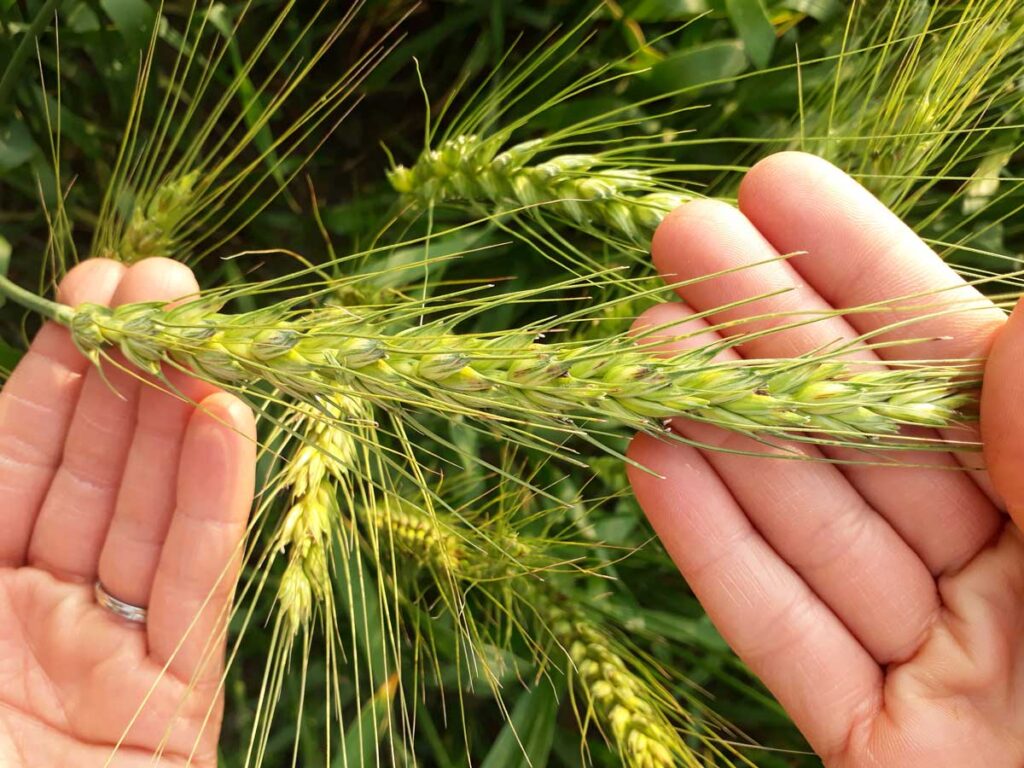Wheat is one of the most widely grown crops globally, yet for many farmers the exact variety of wheat growing in their fields is a mystery. For the first time, extensive studies using DNA fingerprinting technologies are revealing granular detail about the kinds of wheat growing in Nepal and Bangladesh and providing insights to boost the productivity of this crucial food security crop.
Conducted by researchers from Cornell, Sathguru Management Consultants, and National Agricultural Research Centers in Bangladesh and Nepal, the studies not only helped identify the popular varieties but also uncovered the widespread use of older and in some cases decommissioned varieties. The assessment will not only contribute to the understanding of the impact of crop improvement in food security and income growth but also aid research prioritization and inform variety replacement strategies.
Wheat grain samples collected from the farmers’ fields and breeders’ lines from Nepal and Bangladesh were genotyped using Diversity Arrays Technology sequencing (DArTseq)-based single nucleotide polymorphism (SNP) markers. The distribution of field samples was mapped across the wheat-growing provinces based on geo-coordinates recorded during field sample collection. Each of the field samples was profiled and compared with the panel of reference profiles.
The study in Bangladesh revealed that among the varieties grown, BARI Gom 25 represented 29% of the collected samples followed by 23% of BARI Gom 24 and 16% of BARI Gom 26. These three most common varieties were well distributed across the six regions and have broad adoption. The study carried out in Nepal revealed that ‘Gautam’ and ‘Vijay’ are the most popular wheat varieties planted in the plain areas of Nepal. The area covered in these varieties during the 2018–2019 wheat season was 20.3 and 19.5% respectively. ‘WK1204’ was popular and mostly planted in the mountainous areas of Nepal during the October–May cropping season.

Accurate and reliable information on the adoption rates of varieties is essential
Traditionally, evaluation of varietal adoption relies on phenotypic identification through expert opinion and/or farmer’s identification during household surveys. However, previous studies have shown that information gathered during these surveys has an accuracy of around 30%, particularly in countries where informal seed systems are prevalent. Phenotypic identification can also vary due to genetic and environmental influences.
These challenges can be overcome by the application of molecular marker technologies to identify varieties grown in farmer fields. Known as DNA fingerprinting, these technologies are becoming widely available, more affordable, offer a reliable method to address the challenges of morphological varietal identification, and can help to accurately identify varieties grown by farmers at any crop stage.
Fingerprinting data can be used to efficiently track varietal adoption, farmers’ preference, vulnerabilities of a crop when a new pathogen strain or disease is identified, and the impact of wheat breeding interventions by national programs and private industry.
DNA fingerprinting technologies are becoming widely available and more affordable
These technologies offer a reliable method to address the challenges of morphological varietal identification, and can help to accurately identify varieties grown by farmers at any crop stage. DNA fingerprinting can be a feasible alternative approach to assess the adoption rates rather than relying on farmer identification. Genome-wide markers, such as single nucleotide polymorphisms (SNPs), can be used to identify the field samples based on the genetic distance estimates between the sample and varieties represented in a reference library. This approach has been successfully applied to track the adoption of wheat varieties in Afghanistan, Ethiopia and now in Bangladesh and Nepal. This method has also been used in other crops including cassava, rice, maize, and in common bean. The resulting analysis can offer an objective assessment of the purity of the seeds at the breeder level, at the farm level, and the genetic heterogeneity of commercial seeds in the market.
To reduce the use of low-yielding and disease susceptible varieties which are still quite popular in some provinces, appropriate variety adoption as well as withdrawal strategies must be designed. A detailed study focused on farmers’ preferences and seed availability should be conducted to determine why these varieties continue to be cultivated in these provinces instead of newer improved varieties released by National Wheat Research centres. Purity of the reference samples is the key in DNA fingerprinting studies and it is critical that varietal purity of the parent material is maintained. The study also showcases the need for improving the management of breeder seed to ensure quality seed production, uniformity of wheat growing in farmers’ fields, and to accurately assess variety adoption in the future. These analyses will help in developing a strategy to improve seed replacement rate, which is crucial to reap the benefits of new varieties and the investments made in wheat breeding programs.
This study was supported by the Delivering Genetic Gain in Wheat (DGGW) funded by the Bill & Melinda Gates Foundation and UK Foreign, Commonwealth & Development Office (FCDO).
Written by Vijay Paranjape, Poornima Gade, Rijuta Garapaty, Rituparna Majumder & Maricelis Acevedo






